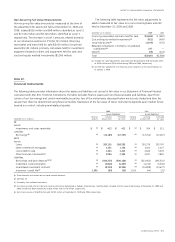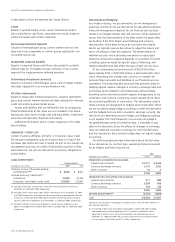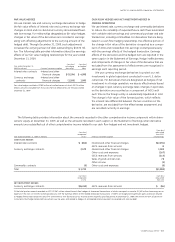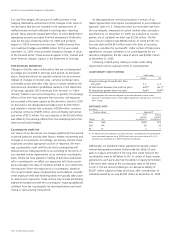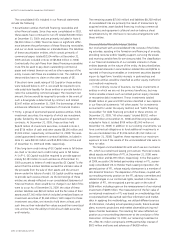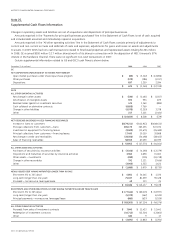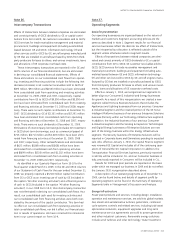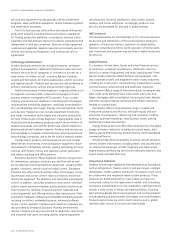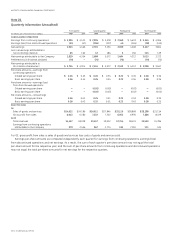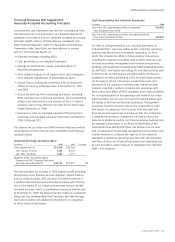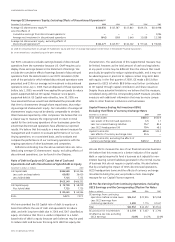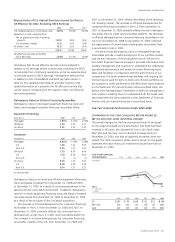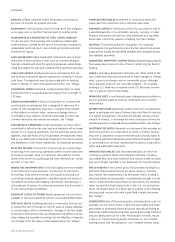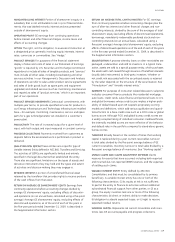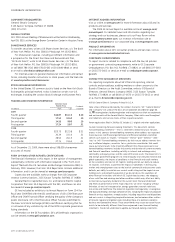GE 2009 Annual Report Download - page 113
Download and view the complete annual report
Please find page 113 of the 2009 GE annual report below. You can navigate through the pages in the report by either clicking on the pages listed below, or by using the keyword search tool below to find specific information within the annual report.
GE 2009 ANNUAL REPORT 111
Note 26.
Intercompany Transactions
Effects of transactions between related companies are eliminated
and consist primarily of GECS dividends to GE or capital contri-
butions from GE to GECS; GE customer receivables sold to GECS;
GECS services for trade receivables management and material
procurement; buildings and equipment (including automobiles)
leased between GE and GECS; information technology (IT) and
other services sold to GECS by GE; aircraft engines manufactured
by GE that are installed on aircraft purchased by GECS from third-
party producers for lease to others; and various investments, loans
and allocations of GE corporate overhead costs.
These intercompany transactions are reported in the GE and
GECS columns of our financial statements, but are eliminated
in deriving our consolidated financial statements. Effects of
these eliminations on our consolidated cash flows from operat-
ing, investing and financing activities include the following. Net
decrease (increase) in GE customer receivables sold to GECS of
$(39) million, $90 million and $(255) million have been eliminated
from consolidated cash from operating and investing activities
at December 31, 2009, 2008 and 2007, respectively. Capital
contributions from GE to GECS of $9,500 million and $5,500 mil-
lion have been eliminated from consolidated cash from investing
and financing activities at December 31, 2009 and 2008, respec-
tively. There were no such capital contributions at December 31,
2007. GECS dividends to GE of $2,351 million and $7,291 million
have been eliminated from consolidated cash from operating
and financing activities at December 31, 2008 and 2007, respec-
tively. There were no such dividends at December 31, 2009.
Eliminations of intercompany borrowings (includes GE investment
in GECS short-term borrowings, such as commercial paper) of
$715 million, $(471) million and $2,049 million have been elimi-
nated from financing activities at December 31, 2009, 2008
and 2007, respectively. Other reclassifications and eliminations
of $623 million, $(188) million and $(828) million have been
eliminated from consolidated cash from operating activities
and $(699) million, $(320) million and $1,202 million have been
eliminated from consolidated cash from investing activities at
December 31, 2009, 2008 and 2007, respectively.
As identified in our Quarterly Report on Form 10-Q for the
fiscal quarter ended March 31, 2009, in the GE and GECS columns
of our Statement of Cash Flows for the year ended December 31,
2008, we properly reported a $5,500 million capital contribution
from GE to GECS as an investing use of cash by GE (included in
the caption “All other investing activities”) and a financing source
of cash to GECS (included in the caption “All other financing
activities”). In our 2008 Form 10-K, this intercompany transaction
was not eliminated in deriving our consolidated cash flows. As a
result, our consolidated cash used for investing activities and
our consolidated cash from financing activities were both over-
stated by the amount of the capital contribution. This item had
no effect on our consolidated cash from operating activities or
total consolidated cash flows, nor did it affect our financial posi-
tion or results of operations. We have corrected this immaterial
item in our current report on Form 10-K.
Note 27.
Operating Segments
Basis for presentation
Our operating businesses are organized based on the nature of
markets and customers. Segment accounting policies are the
same as described in Note 1. Segment results for our financial
services businesses reflect the discrete tax effect of transactions,
but the intraperiod tax allocation is reflected outside of the
segment unless otherwise noted in segment results.
Effects of transactions between related companies are elimi-
nated and consist primarily of GECS dividends to GE or capital
contributions from GE to GECS; GE customer receivables sold to
GECS; GECS services for trade receivables management and
material procurement; buildings and equipment (including auto-
mobiles) leased between GE and GECS; information technology
(IT) and other services sold to GECS by GE; aircraft engines manu-
factured by GE that are installed on aircraft purchased by GECS
from third-party producers for lease to others; and various invest-
ments, loans and allocations of GE corporate overhead costs.
Effective January 1, 2010, we reorganized our segments to
better align our Consumer & Industrial and Energy businesses
for growth. As a result of this reorganization, we created a new
segment called Home & Business Solutions that includes the
Appliances and Lighting businesses from our previous Consumer
& Industrial segment and the retained portion of the GE Fanuc
Intelligent Platforms business of our previous Enterprise Solutions
business (formerly within our Technology Infrastructure segment).
In addition, the Industrial business of our previous Consumer
& Industrial segment and the Sensing & Inspection Technologies
and Digital Energy businesses of Enterprise Solutions are now
part of the Energy business within the Energy Infrastructure
segment. The Security business of Enterprise Solutions will be
reported in Corporate Items and Eliminations pending its expected
sale. Also, effective January 1, 2010, the Capital Finance segment
was renamed GE Capital and includes all of the continuing oper-
ations of General Electric Capital Corporation. In addition, the
Transportation Financial Services business, previously reported
in GECAS, will be included in CLL and our Consumer business in
Italy, previously reported in Consumer, will be included in CLL.
Results for 2009 and prior periods are reported on the basis
under which we managed our business in 2009 and do not reflect
the January 2010 reorganization described above.
A description of our operating segments as of December 31,
2009, can be found below, and details of segment profit by
operating segment can be found in the Summary of Operating
Segments table in Management’s Discussion and Analysis.
Energy Infrastructure
Power plant products and services, including design, installation,
operation and maintenance services, are sold into global markets.
Gas, steam and aeroderivative turbines, generators, combined
cycle systems, controls and related services, including total asset
optimization solutions, equipment upgrades and long-term
maintenance service agreements are sold to power generation
and other industrial customers. Renewable energy solutions
include wind turbines and solar technology. Water treatment


